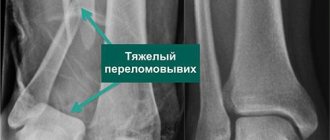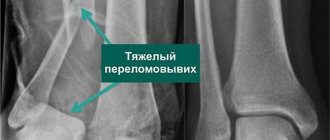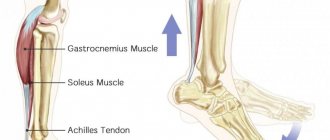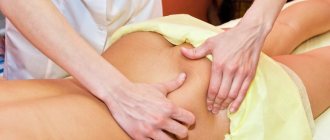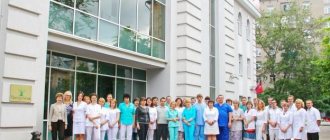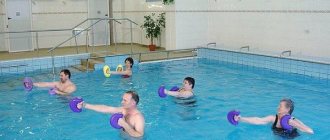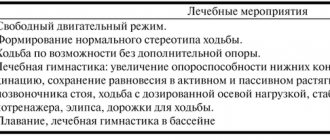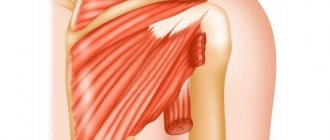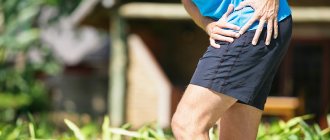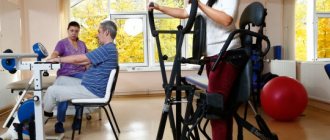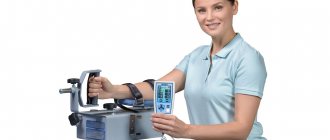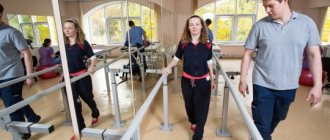- What is an ankle fracture?
- When is massage done?
- Massage after surgery
- Methodology
- The role of massage in patient recovery
After a fracture of the ankle (ankle), closed reduction and immobilization of the limb or surgery is required. During the recovery phase, massage is used. It can be used as early as 3-4 days after injury. This procedure is also used at the stage of late recovery, when the plaster is no longer there, the callus has formed, and the person begins measures aimed at fully restoring the function of the damaged limb.
ankle fracture
ankle fracture
The ankle is the distal part of the fibula and tibia (lateral and medial malleolus, respectively), which performs the most important function: it stabilizes the ankle joint. They form the ankle fork, which holds and distributes the weight of the entire human body.
Ankle fractures account for about 15% of all bone fractures. They are one-, two- and three-malleolar (in the latter case there is also a fracture of the posterior edge of the distal metaepiphysis of the tibia). Most often these are complex injuries. At the same time, not only the ankles are damaged, but also the ligaments, and subluxations of the foot are noted. In 10% of cases, a rupture of the distal tibiofibular syndesmosis occurs.
In most cases, patients are managed conservatively. Approaches used:
- Anesthesia. Half an hour before the bone reposition procedure, narcotic analgesics (for example, promedol solution) are administered. Local anesthesia is performed directly. It can be conductive. In this case, the tibial and peroneal nerves are blocked. It is also possible to inject local anesthetics into the ankle joint.
- Closed reduction of bone fragments. After achieving an analgesic effect and eliminating stress in the patient, reduction begins using the closed method. All movements are made smoothly, without jerking. The effect is reversed to the mechanism of injury.
- Application of a plaster cast. Performed under X-ray control. Subsequently, the person remains in the hospital for several days. He receives analgesics to reduce pain.
With the advent of fixation devices, the number of operations performed has increased. But their results are not always better than conservative treatment. In addition, two operations are required: during repeated intervention, the installed metal structures are removed. There are also advantages: there is no need for long-term plaster immobilization.
If the patient is managed conservatively, careful monitoring is required. Especially in the case of ruptures of the deltoid ligament or tibiofibular syndesmosis. Because in this case, subluxation of the foot is possible after the swelling is eliminated. After 10 days, x-rays of the joint are repeated to determine whether the ankle joint remains stable.
Ankle immobilization
For complete ruptures and significant tears of the ligaments, plaster immobilization or external fixation devices are used. However, they are effective only in the early stages, before a person has developed instability of the ankle joint. For old injuries that are more than 2-3 months old, these methods do not give the expected result.
If a person’s ligament rupture is not detected in time or he does not receive quality treatment, he develops ankle instability. In this case, no immobilization will help restore the function of the joint. And in order to return to work, it is necessary to undergo surgery.
massage
massage
Auxiliary procedures for normal restoration of function of the lower limb begin to be used from the first days of immobilization. Use:
- physical therapy (mainly static loads);
- massage.
Ankle massage is not performed after an ankle fracture. Massage the tissue nearby. Procedures begin on the 3rd day. A total of 10 sessions are required. They aim to:
- elimination of swelling;
- pain reduction;
- increased blood circulation;
- preparing muscles for upcoming physical exercises.
In combination with physical therapy, massage helps prevent atrophic changes in muscle tissue that are inevitable as a result of prolonged immobilization. After all, the load on the muscles decreases. Being at rest for a long time, blood flow in them worsens and muscle volume decreases.
After 3-6 weeks, the permanent bandage can be replaced with a removable one. During this same period, rehabilitation measures begin. Now physical therapy involves performing dynamic exercises. Only flexion and extension at the ankle joint is allowed. More complex movements (eversion, inversion, lateral deviations) are carried out no earlier than 2 weeks after the removal of the cast.
During the same period, several more massage sessions are performed. Both full loads on the foot and massage procedures begin only after an x-ray has been taken and the formation of a bone callus has been confirmed. Massage helps to quickly develop a joint, eliminate stiffness, and build up lost muscle mass.
Transosseous osteosynthesis
Today, osteosynthesis is carried out using hinge-distraction devices and skeletal traction devices. The technique allows you to reliably fix bone fragments, which creates ideal conditions for their fusion.
The main advantage of transosseous osteosynthesis is that it does not require open surgery. The disadvantage is that it does not always allow bone fragments to be compared. Therefore, transosseous osteosynthesis can be combined with surgery. First, the fragments are connected surgically, and why the bones are additionally fixed with an external fixation device.
Massage after surgery
Massage after surgery
- Open fractures - in this case, at least primary surgical treatment of the wound is required. Often it is necessary to perform bone reduction using an open method.
- Location of tendons between bone fragments.
- Trimalleolar fracture, when the fragment of the posterior edge of the tibia constitutes more than 30% of the articular area.
- Displacement of the fragment of the posterior edge that persists after closed reduction by more than 3 millimeters.
- Impossibility of closed reduction due to severe swelling.
After surgery, massage begins a few days later, after the pain has subsided. The impact is carried out in the most gentle way possible. Massage tissues that are located at some distance from the damaged area. In the immediate vicinity of the ankle, they limit themselves to only stroking.
A few weeks after the injury, when the damaged bones are healing, massage can also be used. It goes well with exercise therapy and can be an alternative to physiotherapeutic techniques or complement them. Massage is done several times a day, including before performing dynamic exercises.
Open reduction with internal fixation
The method is used to treat complex fractures when manual reposition of fragments and holding them in the desired position with the help of plaster is impossible. To compare bone fragments and securely fix them, submersible elements and structures are used:
- tie bolts;
- screws;
- bolts with clamp terminals;
- Kirschner wires;
- bolts with flexible rod;
- lavsan ribbons and so on.
Open reduction ensures immediate accurate comparison of fragments and their reliable fixation. After surgery, early weight-bearing ability of the limb is often preserved, which allows it to be loaded soon after surgery. Nevertheless, many experts are confident that none of the methods of open reduction can ensure complete immobility of bone fragments. Therefore, after surgery, patients require additional plaster immobilization.
Operative comparison and fixation of fragments has other disadvantages:
- Injury to soft tissue at the surgical site.
- Risk of developing infectious complications.
- The likelihood of secondary displacement of fragments due to failure of fixators.
- High incidence of pseudarthrosis.
In some cases, closed fractures are best treated by skeletal traction or transosseous osteosynthesis. These methods exclude the intervention of a traumatologist in the natural healing process. Regeneration is accelerated because the doctor does not remove the hematoma and does not damage the muscles, blood vessels, or periosteum. And the opposition of fragments and stretching of soft tissues additionally stimulates regenerative processes.
Methodology
Methodology
In the initial period after injury, suction massage is used. Its main goal is to eliminate swelling, prevent congestion, and improve lymph circulation. The main impact is on the thigh. In the area of the lower leg, only stroking is limited if it is not painful for the patient.
After the period of plaster immobilization is completed, a deeper massage effect is carried out. It consists mainly of stroking and kneading techniques. Massage the thigh and lower leg.
Directly the area of the foot and ankle joint begins to be intensively affected only 2 weeks after the removal of the plaster and radiological confirmation of the successful formation of a bone callus. Stroking techniques are used, as well as spiral rubbing. During the same period, the thigh massage is stopped. Instead, a deep calf massage is performed.
Not only manual, but also hardware massage is used. The main method of influence is vibration.
Endoprosthetics and arthrodesis
Surgeries on the ankle joint are performed mainly for severe post-traumatic osteoporosis, which is accompanied by severe pain and limited mobility of the ankle.
Young patients often undergo endoprosthesis replacement - replacement of a joint with an artificial endoprosthesis. This operation allows you to completely restore the function of the ankle. When endoprosthesis replacement is not possible (old age, severe concomitant diseases), the patient undergoes arthrodesis - immobilization of the joint. This operation is resorted to as a last resort.
Let's summarize:
- Torn ligaments and ankle fractures often occur at a young age. They are difficult to treat and often lead to disability.
- Fresh injuries are much easier to treat. The sooner a person receives medical help, the higher the chances that joint function will be restored.
- To treat injuries, different methods are used, ranging from conservative treatment to surgical treatment.
- The choice of treatment method depends on many factors. The severity and duration of the injury, ankle instability, the degree of post-traumatic osteoporosis, etc. play a role.
- Surgery is a radical method of treatment. As a rule, surgery is performed when it is impossible to restore the function of the joint in other ways.
The role of massage in patient recovery
Ankle massage after an ankle fracture plays a supporting role in the treatment of patients. This is evidenced by the obvious fact that without performing this procedure, the bones heal successfully, and the person is completely restored with the right approach to treatment. At the same time, massage alone, without other methods of treatment (full reposition of fragments, immobilization or surgery) will not lead to anything good.
However, not only the result of treatment is important, but also the patient’s feelings, the functionality of his limb after the end of therapy, and the rate of recovery. It is to influence these indicators that massage of the ankle joint is performed after an ankle fracture. Using the procedure 3 days after permanent immobilization or in the early postoperative period allows a person to reduce swelling and pain, provide good conditions for the formation of callus, and also protect muscle tissue from atrophic changes.
Massage is also performed at the stage of the late rehabilitation period. It is done when the plaster has already been removed, some time has passed, and the person is allowed to put maximum load on the limb. Physical therapy comes to the fore in restoring the patient’s ability to work. It is this that allows you to develop the joint and strengthen the muscles. But massage helps increase the effectiveness of training by improving microcirculation, preparing muscles for upcoming loads, or, on the contrary, relaxing them after training.
Prices for rehabilitation services
Cost of stay from 1500 rub. day.
| Services list | Cost of services |
| Initial consultation with a therapist for residents | For free |
| Consultation with a specialist doctor | 1500 |
| Speech therapist | 1500 |
| Psychologist | 1500 |
| Manual therapy | 1500 |
| Electrocardiogram with interpretation | 900 |
| Ultrasound examination (ultrasound) | 1000 |
| Physiotherapeutic procedures | 700 |
| Physiotherapy | 750 |
| General massage (back, neck) | 1000 |
| Foot massage | 600 |
| Hand massage | 400 |
| IV | 700 |
| IV administration of drugs | 300 |
| IM administration of drugs | 250 |
| Setting up a cleansing enema | 300 |
| Laboratory diagnostics | According to the price list |
Center specialists
Braescu Marina Nikolaevna
Physical therapist with 9 years of experience
Somov Evgeniy Vadimovich
Neurologist • Rehabilitologist • Chiropractor with 7 years of experience
Poznyak Anastasia Dmitrievna
Physical therapist • Massage therapist • Yoga therapist 3 years experience
Abdrakhmanova Yulia Faritovna
Physical therapist • Pilates trainer with 6 years of experience
Personalized approach
We draw up a rehabilitation plan depending on the individual characteristics of each patient
Evidence-based medicine
We use rehabilitation methods that have proven their effectiveness in practice
Powerful diagnostic base
The project was created with the support of a network of diagnostic clinics CMRT, operating for more than 10 years
European equipment
We use only the most modern, proven equipment for comfortable rehabilitation
Description of exercise sets
Therapeutic techniques aimed at rehabilitation after a foot fracture at home include morning exercises, standing exercises, moving exercises, and sitting exercises.
Morning exercises are so-called hygienic exercises, which should be done immediately after waking up. It consists of three parts. The first part must be done in bed - bend and straighten your toes, rotate it outward and inward, and make circular movements. Then it is recommended to perform self-massage with cream or ointment.
General developmental exercises that need to be done in the morning:
- sequential lifting onto your toes and lowering onto your heels;
- the knee of one leg bends, hands rest on the wall; the second leg is laid back on the toes; the calf muscle and Achilles tendon are severely stretched;
- feet standing parallel to each other roll from the outside to the inside;
- the knees rise to the chest, the ankle stretches;
- lunge to the side with the body turned to the side.
Important. It is best to do the exercises barefoot for 30-40 minutes.
Rehabilitation after a foot fracture:
- the toes are bent in such a way that the emphasis is on the outer side of the feet;
- rolling from heel to toe;
- half-squat position, feet simultaneously rolling left and right;
- squat position, heels off the floor.
These exercises are performed in 2 sets of 10-15 times.
Popular movement exercises:
- jumping in place: legs are placed apart and brought together again;
- walking backwards;
- walking on all fours;
- jumping with the right and left foot alternately;
- jogging.
You can also stretch your injured foot while sitting:
- a tennis ball is rolled back and forth by the foot;
- pick up a rag or towel with your toes;
- the towel is wrapped around the ankle and pulled towards itself;
The entire set of exercise therapy exercises given above is recommended to be done in a static position. This could be swallow pose.
Also, over time, you can add exercises with another popular simulator:
Petr Popov developed his own system for foot rehabilitation after a fracture. It is based on micro movements that make the whole body work. Such a small load on damaged bones, according to many experts, gives the best effect.
